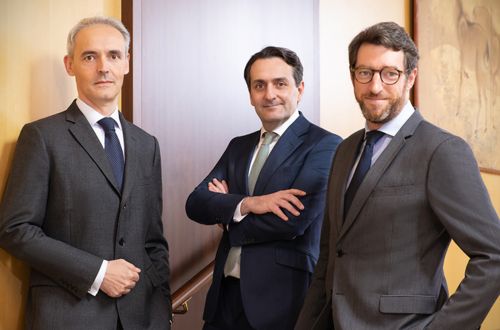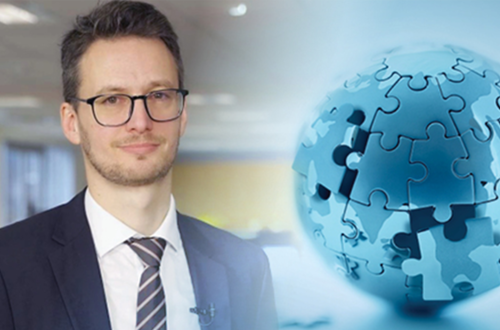Structured Products management mandate: a highly innovative offer

In France, Indosuez now allows its clients to entrust a specialist with managing their structured product portfolio. To find out more about this innovative offer as well as its features and advantages, we interviewed Franck Birchenall, Head of Structured Products.
Can you remind us what a structured product is?
Structured products are financial instruments that stand out for their ability to generate returns over a given period while potentially offering partial or full protection of the capital invested at maturity.
The risk/return ratio of structured products is therefore defined according to their level of protection, their underlying assets, and their maturity.
Why did you choose to propose a management mandate dedicated to structured products?
We created the Structured Products management mandate after some of our clients indicated that they wanted to entrust an expert with setting up and managing a portfolio invested in structured products. Our team in France has all the know-how to set up an offer like this, and we know that has been highly appreciated by clients of Indosuez’s other international entities.
However, I want to make it clear that it is not intended for all our clients. They must have a risk profile compatible with holding a dynamic securities account as well as sufficient knowledge of structured products. In addition, it is available from €500,000 for a recommended period of eight years. We also recommend that clients not invest more than 15% of their financial assets in this asset class.
What are the strengths of the Structured Products management mandate?
The Structured Products management mandate allows us to benefit from the expertise of our managers dedicated exclusively to this activity.
They are responsible for selecting investments and ensuring that the portfolio is well diversified in terms of sectors, themes, or mechanisms.
They also decide on portfolio reallocations based on the progress of the invested products and the opportunities presented by the market, including on the secondary market.
They also keep a constant eye on the markets and the portfolio’s valuation. They monitor risk/return levels as well as product redemptions and reinvestments.
Clients benefit not only from dynamic portfolio management but also from the manager’s full experience in investment timing and reuse of non-invested assets.
Using a manager can remove all the constraints inherent in managing a portfolio, from product selection to asset monitoring as well as investment periods and processes.
What about capital protection?
To ensure optimal protection of the assets entrusted to us, the selected products are structured with partial capital protection at maturity.
In addition, the managers decide on the investment timing to offer our clients the best conditions. For example, a portfolio of structured products is put together gradually according to market conditions over a period of up to nine months.
During the life of the mandate, they are part of a responsive, flexible management process that allows them to seize market opportunities and reduce phases of non-investment.
Lastly, we ensure a regular return by offering mainly structured products with mechanisms for regular payment of conditional coupons* that are reinvested under the mandate or, where appropriate, with mechanisms for capitalisation of the coupon* (paid if the product reaches maturity).
* These coupons are subject to the correct implementation of the structured products offering.
How do the managers get to the range of diversified products you’re talking about?
Their task is to seek the solution that is most in line with the mandate objective but also as competitive as possible. To do this, they work on a broad range of multi-asset class investments.
So, there are various types of products. There are multiple underlying assets (equities, bonds, currencies, equity indices, commodities, etc.) and numerous coupon, redemption, and capital protection mechanisms.
The managers also work in an open architecture with a wide range of issuers chosen for each product creation for their financial soundness, price competitiveness, and service quality.
Despite the mandate structure, is it possible to impose certain management constraints?
This possibility is available to our clients who want to invest at least €5 million in a Structured Products management mandate. However, we make sure that the constructed portfolio is diversified, and we recommend an exposure of no more than 10% per product.
What are the main risks for an investor?
The main disadvantages are inherent in the very nature of structured products. Examples include credit risk, liquidity risk, interest rate risk, market risk, capital loss risk, and currency risk[1].
[1] Capital loss risk: the product’s redemption value may be less than the amount initially invested. In the worst-case scenario, investors may lose their entire investment. Credit risk: investors are exposed to a potential default by the issuer or guarantor, which creates a risk for the product’s redemption. Liquidity risk: if investors wish to resell a Structured Product before maturity, they may encounter weak market liquidity, which can have a negative impact on the price at which the product can be sold. Interest rate risk: interest rate risk is the risk incurred by the holder due to the subsequent trend in interest rates. There are two elements to this risk: the general risk related to the trend in interest rates and the specific risk related to the market’s assessment of the issuer (through ratings). Market risk: if the return on the Structured Product is related to the trend in a basket of stocks, an index, or another market parameter, this trend cannot be guaranteed so that the return at maturity could be zero or negative. During the life of the product, any declines in the market could cause the quoted price to fall below the nominal value. Currency risk: if a product is issued in a foreign currency and does not incorporate currency hedging, there is a capital loss risk generated by fluctuations in exchange rates.
Under no circumstances may this article be construed as an offer to purchase a life insurance contract or capital bond, as an offer or a solicitation, or as an act of direct marketing for the purchase of financial products or services. It has not been designed and is not intended for persons in any particular country. It is not intended for persons who are citizens, domiciled for tax purposes or resident in a country or jurisdiction where its distribution, publication, availability, or use would breach the applicable law or regulations. You are encouraged to read the KIID (or the prospectus), the Key Information Document, the Detailed Notice, or the final terms and conditions of the product or service carefully before investing. Past performance is not a reliable indicator of future results, and the value of an investment may increase or decrease depending on developments in the financial markets.
July 08, 2020




